中考第一轮复习人教新目标九年级英语全册Unit 10-12词汇短语复习课件
文档属性
| 名称 | 中考第一轮复习人教新目标九年级英语全册Unit 10-12词汇短语复习课件 |

|
|
| 格式 | pptx | ||
| 文件大小 | 195.3KB | ||
| 资源类型 | 试卷 | ||
| 版本资源 | 人教新目标(Go for it)版 | ||
| 科目 | 英语 | ||
| 更新时间 | 2025-03-07 11:47:26 | ||
图片预览

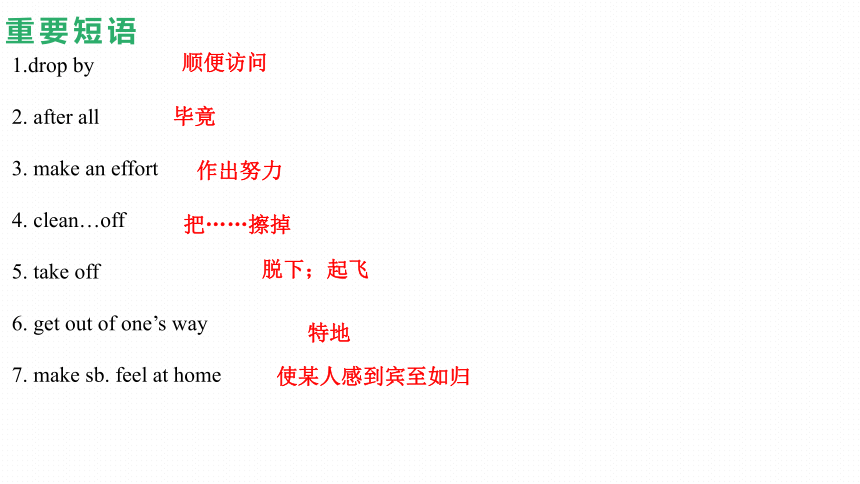
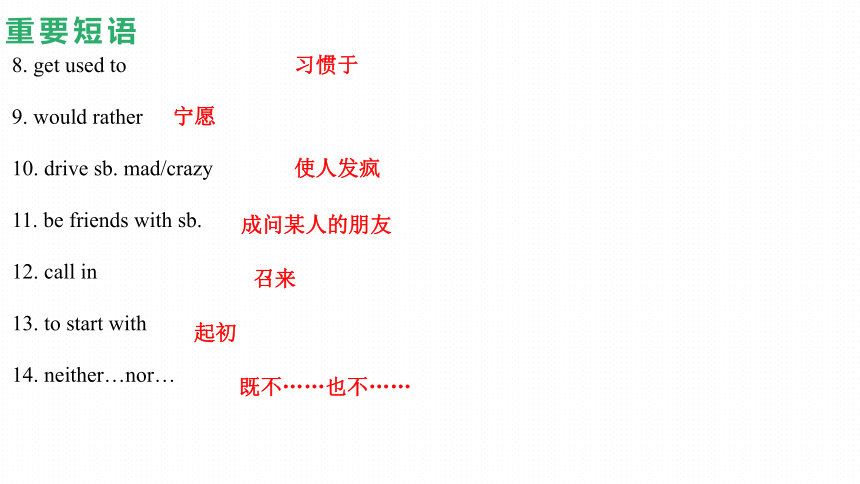
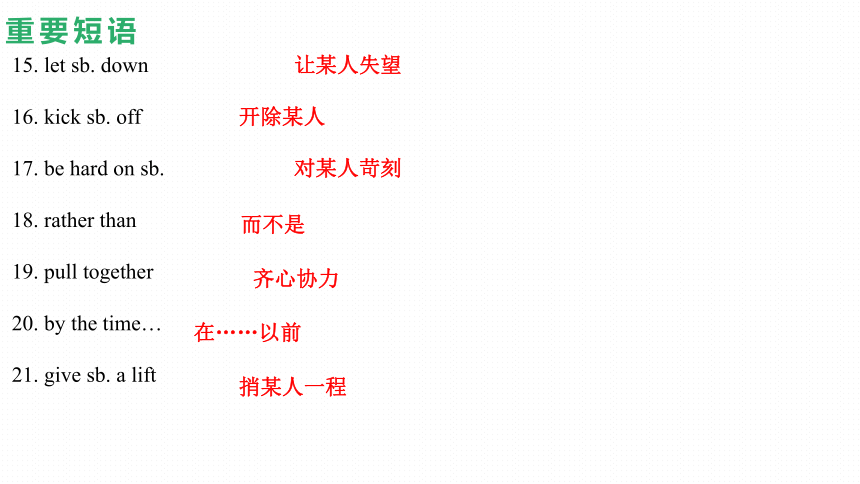

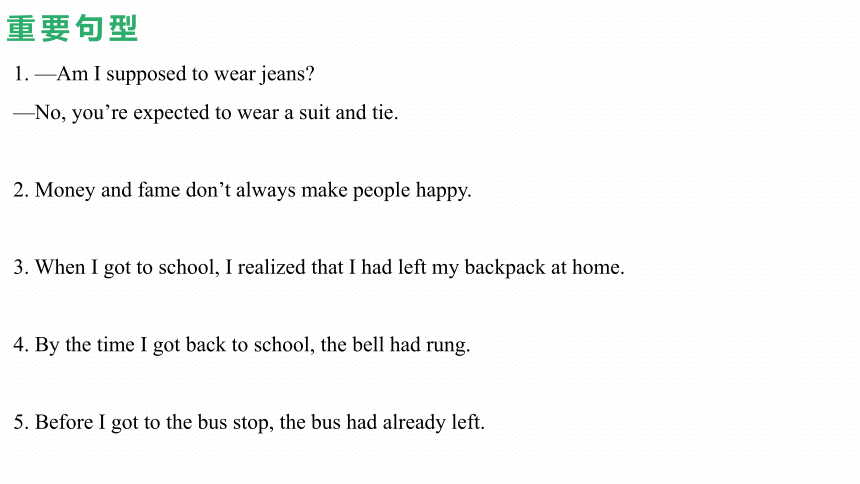



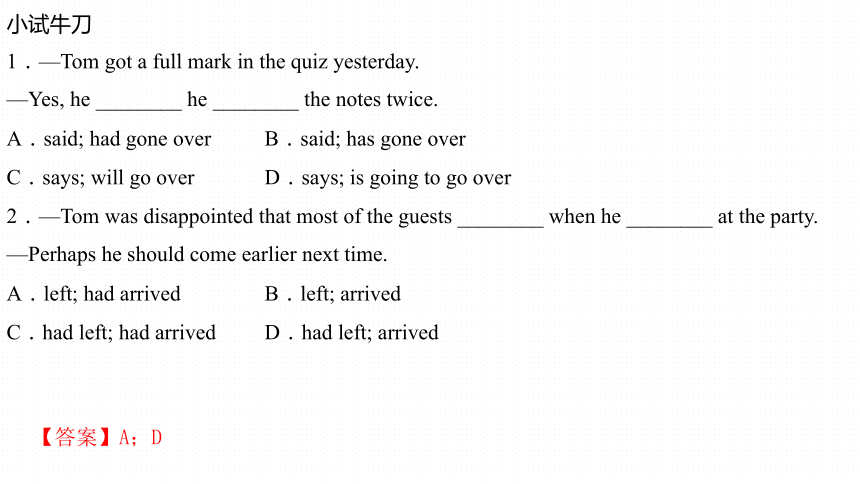


文档简介
(共31张PPT)
Unit 10-12词汇短语复习
九
最新人教版
全册
单元总复习
/ 让教学更有效 高效备考| 英语学科
1.drop by
2. after all
3. make an effort
4. clean…off
5. take off
6. get out of one’s way
7. make sb. feel at home
重要短语
顺便访问
毕竟
作出努力
脱下;起飞
特地
把……擦掉
使某人感到宾至如归
8. get used to
9. would rather
10. drive sb. mad/crazy
11. be friends with sb.
12. call in
13. to start with
14. neither…nor…
重要短语
习惯于
宁愿
使人发疯
召来
起初
成问某人的朋友
既不……也不……
15. let sb. down
16. kick sb. off
17. be hard on sb.
18. rather than
19. pull together
20. by the time…
21. give sb. a lift
重要短语
让某人失望
开除某人
对某人苛刻
齐心协力
在……以前
而不是
捎某人一程
22. in line with…
23. show up
24. by the end of
25. sell out
重要短语
与……成一排
露面
在某时间点以前
卖光
1. —Am I supposed to wear jeans
—No, you’re expected to wear a suit and tie.
2. Money and fame don’t always make people happy.
3. When I got to school, I realized that I had left my backpack at home.
4. By the time I got back to school, the bell had rung.
5. Before I got to the bus stop, the bus had already left.
重要句型
Unit 10-12
语法汇集
九年级
最新人教版
全册
/ 让教学更有效 高效备考| 英语学科
1.过去完成时
【用法总结】
过去完成时的构成为“had+过去分词”,表示在过去某一时间点或动作之前就已经完成的动作。这个过去的时间点常用by,before等引导的介词短语或时间状语从句表示。
1.过去完成时的句式
例 When the police arrived, the thief had run away.
警察赶到时,小偷已经逃跑了。
例—Had you learnt Japanese before you went to Japan
你去日本之前学过日语吗?
肯定句 主语+had+过去分词+其他.
否定句 主语+had not+过去分词+其他.
一般疑问句 Had+主语+过去分词+其他
—Yes, I had./No, I hadn't.是的,我学过。/不,我没有。
2.某些特殊句式中常用过去完成时
(1)在“hardly…when…”“no sooner…than”结构中,主句常用过去完成时。
例 No sooner had I seen him than I asked him about the matter.
我一见到他,就问及那件事情。
(2)在“It/That was the first/second…time that…”结构中,that后的从句用过去完成时。(在“It/That is the first/second…time that…”结构中,that后的从句用现在完成时。)
例 It was the first time that she had found the wild man.这是她第一次发现野人。
小试牛刀
1.—Tom got a full mark in the quiz yesterday.
—Yes, he ________ he ________ the notes twice.
A.said; had gone over B.said; has gone over
C.says; will go over D.says; is going to go over
2.—Tom was disappointed that most of the guests ________ when he ________ at the party.
—Perhaps he should come earlier next time.
A.left; had arrived B.left; arrived
C.had left; had arrived D.had left; arrived
【答案】A;D
2.动词不定式
【用法总结】
1.动词不定式的形式、特征
动词不定式的基本形式是“to+动词原形”。有时to可以省略,此时称为不带to的动词不定式。否定形式是“not to+动词原形”。
例 Jack's teacher asked him to turn off the lights after class.杰克的老师让他下课后关灯。
2.动词不定式的基本用法
作主语 动词不定式作主语时,谓语动词用单数形式。常用it作形式主语,而将真正的主语即动词不定式放于句末。常用句式为“It is+adj(+for/of sb.)+to do sth."或“It is+n.+to do sth.”
作宾语 只跟不定式作宾语的动词:decide决定 want想要 hope希望 agree同意expect期望 manage成功做成 refuse拒绝 offer提供
作表语 动词不定式作表语时,一般是对系动词前面的名词进行解释说明,可以转换为作主语
作宾语补足 常见的跟带to的不定式作宾语补足语的动词(短语):allow允许 order命令 ask要求 want想要 invite邀请tell告诉 warm警告 advise建议 expect期望 would like想要
语动词不定式作使役动词和感官动词的宾语补足语时,要省略to,但用于被动语态的时候必须加上to(let除外)
作定语 动词不定式作定语时,要放在所修饰名词或代词的后面
作状语 不定式常作目的状语、结果状语和原因状语
3.“疑问词+不定式”结构
动词不定式可以用在疑问词what,how,when,where,which等之后,作主语、宾语、表语等。当“疑问词+不定式”作宾语时,可以和宾语从句转换。
例 He showed me how to use the computer.
=He showed me how I can use the computer.他教我怎样使用电脑。
小试牛刀
1.Would you please tell me ________ next
A.how to do B.what to do C.what do I do D.how should I do
2.I think it is unfair ________ them work ten hours a day.
A.made B.make C.to make D.makes
【答案】B;C
【用法总结】
英语中的感叹句有多种表达法,陈述句、疑问句、祈使句、一个感叹词或短语后面加上感叹号都可以构成感叹句,但常用的感叹句型是what和how引导的感叹句。
what和how引导的感叹句:
What+a/an+形容词+可数名词(单数)(+主语+谓语)!
what+形容词+名词(不可数名词或可数名词复数)(+主语+谓语)!
How+形容词或副词(+主语+谓语)!
例What a beautiful house!多么漂亮的房子啊!
How beautiful a house it is! 多么漂亮的房子啊!
What awful weather! 天气太糟糕了!
[歌诀助记]感叹句并不难,what,how放句首;
what a/an形加名,不可数、复数a/an去;
形容、副词在how后,莫忘感叹号在句末。
3.感叹句
【答案】D;B
1._________ stupid mistake! I’ve lost my backpack!
A.How B.What
C.What an D.What a
2.You can’t imagine ________ when she heard his son enter a famous university.
A.how the woman was excited
B.how excited the woman was
C.how excited was the woman
【用法总结】
“the+比较级...,the+比较级...”结构,表示“越……就越……”。
例The more you speak, the better your English will be.
你说得越多,你的英语就越好。
The more I do this, the more I realize how important it is to record these classes.
我越发感到如此我就更加意识到在课堂上录音的重要性。
4.the more...the more...越……就越……
5.The ________ pressure you put on yourself, the ________ you will do in the exam.
A.more, worse B.less, worse
C.more, worst D.less, worst
6.—To tell you the truth, I’m worried about the entrance exam to high school.
—Take it easy. ________ you are, ________ you will make.
A.The more nervous; the more mistakes
B.The less nervous; the less mistakes
C.The more relaxed; the more mistakes
【答案】A;A
【用法总结】
1. make v. 使,让
表示“使…怎么样”,往往用“make+宾语+adj. /过去分词”结构。另外,make后也可接不带to的动词不定式作宾语补足语,注意此结构在被动语态中,动词不定式要还原to。
2. make的其他词组搭配
make a telephone call打电话make a decision作决定
make a face/make faces做鬼脸make a living 谋生
make up编造make the bed 铺床
make money 赚钱make plans 制订计划
make it实现,做到be made of/from由……制成
5.make的用法
练一练:
1.The boss made his workers ________ 12 hours a day, which was against the law.
A.to work B.working C.worked D.work
2.When summer comes, the sun is always shining brightly, ________ everything there ________ more beautiful.
A.to make; looks B.making; look C.and make; look
【答案】D;B
6.neither...nor...既不……也不……
辨析 neither...nor.../either...or.../not only...but also.../both...and...
neither...nor... 既不……也不…… 若连接两个名词或代词作主语,谓语动词的单复数遵循“就近原则”
either...or... 或者……或者…… not only...but also... 不仅……而且…… both...and... ……和……(两者)都 谓语动词用复数
【拓展】
1. 当neither...nor...连接两个分句,并且neither位于句首时,两个分句都要进行部分倒装,即将助动词、情态动词或连系动词be提到主语之前。
Neither has she changed her mind, nor will she do so.
她既没有改变主意,也不打算这样做。
2. “Neither/Nor+助动词/情态动词/连系动词be+主语”结构常用于表达一个人没有做某事,另一个人也没做同一件事。
They didn't go to the park yesterday.
Neither/Nor did we.
他们昨天没去公园,我们也没去。
3. neither,either用于两者的范围。
练一练:
1.—It’s a pity that ________ my teachers ________ parents allow me to swim alone.
—After all you are too young, safety first.
A.either; or B.neither; nor
C.not only; but also D.both; and
2.— WeChat is very popular. ________ the young ________ the old are interested in it.
— Right. However, it is not good to spend too much time on it.
A.Neither; nor B.Not only; but also C.Either; or
【答案】B;B
【用法总结】
1. rather than连接两个平行结构,表示在两者之中进行选择,既可以表示主观愿望上的抉择,意思是“与其……宁可……”,也可以表示客观程度上的差异,意思是“与其说……不如说……”,它连接的并列成分可以是名词、代词、形容词、介词(短语)、动名词、动词不定式等。
温馨提示
rather than所连接的一定是地位同等的、词性相同的两个成分。
2. 由rather than构成的句型结构,常见的有prefer to do...rather than do...,would do...rather than do...等。
例What made you choose the one rather than the other
你怎么选了这个而不是那个?
7.rather than而不是
练一练
1.It’s raining heavily. I would rather ________ in my room than ________ out.
A.to stay; to go B.stay; go
C.not to stay; go D.not stay; to go
2.I prefer ________ at home rather than ________.
A.to stay; go out B.staying out; going out
C.stay; to go out D.to stay out; to go out
【答案】B ;A
Unit 10-12
基础练习
九年级
最新人教版
全册
/ 让教学更有效 高效备考| 英语学科
1.—I’d like you to tell me something about Changbai Mountain.
—I’m sorry, but neither I nor Jack ________ there.
A.have been B.has been C.have gone D.has gone
2.Happiness is very important. ________ you live, ________ you are. So try your best to make yourself happy every day.
A.The happier, the healthier B.The happier, the more healthy
C.The more happily, the healthier D.The happy, the healthy
3.—________ great advice my parents have offered!
—Yeah. It is always a good idea to ask parents for help when we are in trouble.
A.What a B.What C.How D.How a
4.—You look sad. What’s the matter
—I had a bad morning. By the time I got to school, I found I ________ my homework at home. I had to go back home to get it.
A.have forgottenB.had forgottenC.have left D.had left
5.The boy promised ________ computer games again because it had already taken up much of his time.
A.don’t playing B.not play C.not playing D.not to play
一、单项选择
一、BCBDD
二、1.After all 2.get mad 3.pull together 4.as soon as 5.didn’t untill
二、完成句子
1.不要生气,毕竟,他还是个孩子。
Don’t be angry. ________ ________ he is only a child.
2.如果你即使只迟到十五分钟,你的朋友或许会大动肝火。
If you’re even 15 minutes late, your friend may ________ ________ .
3.但我想只要我们团结一致,我们就会赢得下一场比赛。
But I think if we continue to ________ ________ , we’re going to win the next one.
4.我一到北京就给你打电话。
I will call you ____________________ I arrive in Beijing.|
5.我的老师们直到完成了这项工作才回家。
My teachers ________ go back home ________ they finished this work.
三、完成句子
Sky lanterns are also called Kongming lanterns. It is said that they were invented by Zhuge Kongming, also known as Zhuge Liang. Zhuge Kongming watched the direction of _______ and made a sky lantern with a message for help.
Today, sky lanterns are used at festivals and other celebrations. People get together to fly them into the night sky _______ the sky lanterns are seen as bright symbols of happiness and good wishes. The sky lanterns look like stars that have fallen down to _______ . They shine brightly and dance happily, creating a magical and _______ scene.
Flying sky lanterns is a pleasant experience, but it has certain _______ . It may cause fires if we don’t fly them properly. So, it is very important to follow safety rules and use them in certain locations.
1.A.wind B.cloud C.rain D.snow
2.A.although B.when C.if D.because
3.A.the moon B.the earth C.the sun D.Mars
4.A.harmful B.strange C.fantastic D.noisy
5.A.difficulties B.questions C.risks D.symbols
三、ADBCC
Driverless cars have developed rapidly in China nowadays. Recently, the news of “radish Run fast” (萝卜快跑) has drawn wide attention. Driverless cars are becoming more common in many cities. It has become a hit on social media.
Driverless cars can operate (操作) without a human driver. They can communicate with each other and change their speed and direction as needed, possibly improving traffic conditions and even making traffic lights needless as well. Another main advantage of driverless vehicles is that they reduce the number of accidents on the road, so it will save hundreds and thousands of people’s lives.
However, there are still worries about whether driverless cars are safe for everyone on the road. Even though they use smart technology to avoid dangers and control the car, they’re not perfect yet. In a recent London test, a driver had to take control twice to avoid accidents.
There are a lot of challenges that need to be solved before we see traffic lights disappear. One of these challenges is allowing driverless cars on the roads regularly, which requires solving many safety and technical problems. Driverless cars need sensors (传感器), cameras, and computer systems to operate. However, making these systems work effectively in all weather and road conditions is challenging.
People have mixed feelings about driverless cars. Some people, like Grant Schapps, believe they could be a big deal if we can make them work safely. But some feel uncomfortable with the idea, and most want them to be clearly marked on the road. Experts (专家) think we might need new road signs just for driverless cars because they may have difficulty moving through the roads with heavy traffic or unexpected situations.
In short, while driverless cars offer exciting possibilities, we must deal with many problems before they become common on our roads.
1. What’s the purpose of Paragraph 1
A.To explain an idea. B.To introduce the topic.
C.To advise people to buy driverless cars. D.To tell people how to operate driverless cars.
2. How does the writer show driverless cars are not perfect now
A.By listing numbers. B.By asking a question.
C.By making comparison. D.By giving an example.
3. What does Paragraph 4 mainly talk about
A.Safety of driverless cars. B.Problems of driverless cars.
C.Technology of driverless cars. D.Advantages of driverless cars.
4. What is Grant Schapps’ attitude (态度) about driverless cars
A.Positive. B.Uncertain. C.Worried. D.Doubtful.
5. What does the writer want to tell us
A.Think twice before acting. B.One tree can’t make a forest.
C.The early bird catches the worm. D.Actions speak louder than words.
四、BDBAA
Thank you!
Unit 10-12词汇短语复习
九
最新人教版
全册
单元总复习
/ 让教学更有效 高效备考| 英语学科
1.drop by
2. after all
3. make an effort
4. clean…off
5. take off
6. get out of one’s way
7. make sb. feel at home
重要短语
顺便访问
毕竟
作出努力
脱下;起飞
特地
把……擦掉
使某人感到宾至如归
8. get used to
9. would rather
10. drive sb. mad/crazy
11. be friends with sb.
12. call in
13. to start with
14. neither…nor…
重要短语
习惯于
宁愿
使人发疯
召来
起初
成问某人的朋友
既不……也不……
15. let sb. down
16. kick sb. off
17. be hard on sb.
18. rather than
19. pull together
20. by the time…
21. give sb. a lift
重要短语
让某人失望
开除某人
对某人苛刻
齐心协力
在……以前
而不是
捎某人一程
22. in line with…
23. show up
24. by the end of
25. sell out
重要短语
与……成一排
露面
在某时间点以前
卖光
1. —Am I supposed to wear jeans
—No, you’re expected to wear a suit and tie.
2. Money and fame don’t always make people happy.
3. When I got to school, I realized that I had left my backpack at home.
4. By the time I got back to school, the bell had rung.
5. Before I got to the bus stop, the bus had already left.
重要句型
Unit 10-12
语法汇集
九年级
最新人教版
全册
/ 让教学更有效 高效备考| 英语学科
1.过去完成时
【用法总结】
过去完成时的构成为“had+过去分词”,表示在过去某一时间点或动作之前就已经完成的动作。这个过去的时间点常用by,before等引导的介词短语或时间状语从句表示。
1.过去完成时的句式
例 When the police arrived, the thief had run away.
警察赶到时,小偷已经逃跑了。
例—Had you learnt Japanese before you went to Japan
你去日本之前学过日语吗?
肯定句 主语+had+过去分词+其他.
否定句 主语+had not+过去分词+其他.
一般疑问句 Had+主语+过去分词+其他
—Yes, I had./No, I hadn't.是的,我学过。/不,我没有。
2.某些特殊句式中常用过去完成时
(1)在“hardly…when…”“no sooner…than”结构中,主句常用过去完成时。
例 No sooner had I seen him than I asked him about the matter.
我一见到他,就问及那件事情。
(2)在“It/That was the first/second…time that…”结构中,that后的从句用过去完成时。(在“It/That is the first/second…time that…”结构中,that后的从句用现在完成时。)
例 It was the first time that she had found the wild man.这是她第一次发现野人。
小试牛刀
1.—Tom got a full mark in the quiz yesterday.
—Yes, he ________ he ________ the notes twice.
A.said; had gone over B.said; has gone over
C.says; will go over D.says; is going to go over
2.—Tom was disappointed that most of the guests ________ when he ________ at the party.
—Perhaps he should come earlier next time.
A.left; had arrived B.left; arrived
C.had left; had arrived D.had left; arrived
【答案】A;D
2.动词不定式
【用法总结】
1.动词不定式的形式、特征
动词不定式的基本形式是“to+动词原形”。有时to可以省略,此时称为不带to的动词不定式。否定形式是“not to+动词原形”。
例 Jack's teacher asked him to turn off the lights after class.杰克的老师让他下课后关灯。
2.动词不定式的基本用法
作主语 动词不定式作主语时,谓语动词用单数形式。常用it作形式主语,而将真正的主语即动词不定式放于句末。常用句式为“It is+adj(+for/of sb.)+to do sth."或“It is+n.+to do sth.”
作宾语 只跟不定式作宾语的动词:decide决定 want想要 hope希望 agree同意expect期望 manage成功做成 refuse拒绝 offer提供
作表语 动词不定式作表语时,一般是对系动词前面的名词进行解释说明,可以转换为作主语
作宾语补足 常见的跟带to的不定式作宾语补足语的动词(短语):allow允许 order命令 ask要求 want想要 invite邀请tell告诉 warm警告 advise建议 expect期望 would like想要
语动词不定式作使役动词和感官动词的宾语补足语时,要省略to,但用于被动语态的时候必须加上to(let除外)
作定语 动词不定式作定语时,要放在所修饰名词或代词的后面
作状语 不定式常作目的状语、结果状语和原因状语
3.“疑问词+不定式”结构
动词不定式可以用在疑问词what,how,when,where,which等之后,作主语、宾语、表语等。当“疑问词+不定式”作宾语时,可以和宾语从句转换。
例 He showed me how to use the computer.
=He showed me how I can use the computer.他教我怎样使用电脑。
小试牛刀
1.Would you please tell me ________ next
A.how to do B.what to do C.what do I do D.how should I do
2.I think it is unfair ________ them work ten hours a day.
A.made B.make C.to make D.makes
【答案】B;C
【用法总结】
英语中的感叹句有多种表达法,陈述句、疑问句、祈使句、一个感叹词或短语后面加上感叹号都可以构成感叹句,但常用的感叹句型是what和how引导的感叹句。
what和how引导的感叹句:
What+a/an+形容词+可数名词(单数)(+主语+谓语)!
what+形容词+名词(不可数名词或可数名词复数)(+主语+谓语)!
How+形容词或副词(+主语+谓语)!
例What a beautiful house!多么漂亮的房子啊!
How beautiful a house it is! 多么漂亮的房子啊!
What awful weather! 天气太糟糕了!
[歌诀助记]感叹句并不难,what,how放句首;
what a/an形加名,不可数、复数a/an去;
形容、副词在how后,莫忘感叹号在句末。
3.感叹句
【答案】D;B
1._________ stupid mistake! I’ve lost my backpack!
A.How B.What
C.What an D.What a
2.You can’t imagine ________ when she heard his son enter a famous university.
A.how the woman was excited
B.how excited the woman was
C.how excited was the woman
【用法总结】
“the+比较级...,the+比较级...”结构,表示“越……就越……”。
例The more you speak, the better your English will be.
你说得越多,你的英语就越好。
The more I do this, the more I realize how important it is to record these classes.
我越发感到如此我就更加意识到在课堂上录音的重要性。
4.the more...the more...越……就越……
5.The ________ pressure you put on yourself, the ________ you will do in the exam.
A.more, worse B.less, worse
C.more, worst D.less, worst
6.—To tell you the truth, I’m worried about the entrance exam to high school.
—Take it easy. ________ you are, ________ you will make.
A.The more nervous; the more mistakes
B.The less nervous; the less mistakes
C.The more relaxed; the more mistakes
【答案】A;A
【用法总结】
1. make v. 使,让
表示“使…怎么样”,往往用“make+宾语+adj. /过去分词”结构。另外,make后也可接不带to的动词不定式作宾语补足语,注意此结构在被动语态中,动词不定式要还原to。
2. make的其他词组搭配
make a telephone call打电话make a decision作决定
make a face/make faces做鬼脸make a living 谋生
make up编造make the bed 铺床
make money 赚钱make plans 制订计划
make it实现,做到be made of/from由……制成
5.make的用法
练一练:
1.The boss made his workers ________ 12 hours a day, which was against the law.
A.to work B.working C.worked D.work
2.When summer comes, the sun is always shining brightly, ________ everything there ________ more beautiful.
A.to make; looks B.making; look C.and make; look
【答案】D;B
6.neither...nor...既不……也不……
辨析 neither...nor.../either...or.../not only...but also.../both...and...
neither...nor... 既不……也不…… 若连接两个名词或代词作主语,谓语动词的单复数遵循“就近原则”
either...or... 或者……或者…… not only...but also... 不仅……而且…… both...and... ……和……(两者)都 谓语动词用复数
【拓展】
1. 当neither...nor...连接两个分句,并且neither位于句首时,两个分句都要进行部分倒装,即将助动词、情态动词或连系动词be提到主语之前。
Neither has she changed her mind, nor will she do so.
她既没有改变主意,也不打算这样做。
2. “Neither/Nor+助动词/情态动词/连系动词be+主语”结构常用于表达一个人没有做某事,另一个人也没做同一件事。
They didn't go to the park yesterday.
Neither/Nor did we.
他们昨天没去公园,我们也没去。
3. neither,either用于两者的范围。
练一练:
1.—It’s a pity that ________ my teachers ________ parents allow me to swim alone.
—After all you are too young, safety first.
A.either; or B.neither; nor
C.not only; but also D.both; and
2.— WeChat is very popular. ________ the young ________ the old are interested in it.
— Right. However, it is not good to spend too much time on it.
A.Neither; nor B.Not only; but also C.Either; or
【答案】B;B
【用法总结】
1. rather than连接两个平行结构,表示在两者之中进行选择,既可以表示主观愿望上的抉择,意思是“与其……宁可……”,也可以表示客观程度上的差异,意思是“与其说……不如说……”,它连接的并列成分可以是名词、代词、形容词、介词(短语)、动名词、动词不定式等。
温馨提示
rather than所连接的一定是地位同等的、词性相同的两个成分。
2. 由rather than构成的句型结构,常见的有prefer to do...rather than do...,would do...rather than do...等。
例What made you choose the one rather than the other
你怎么选了这个而不是那个?
7.rather than而不是
练一练
1.It’s raining heavily. I would rather ________ in my room than ________ out.
A.to stay; to go B.stay; go
C.not to stay; go D.not stay; to go
2.I prefer ________ at home rather than ________.
A.to stay; go out B.staying out; going out
C.stay; to go out D.to stay out; to go out
【答案】B ;A
Unit 10-12
基础练习
九年级
最新人教版
全册
/ 让教学更有效 高效备考| 英语学科
1.—I’d like you to tell me something about Changbai Mountain.
—I’m sorry, but neither I nor Jack ________ there.
A.have been B.has been C.have gone D.has gone
2.Happiness is very important. ________ you live, ________ you are. So try your best to make yourself happy every day.
A.The happier, the healthier B.The happier, the more healthy
C.The more happily, the healthier D.The happy, the healthy
3.—________ great advice my parents have offered!
—Yeah. It is always a good idea to ask parents for help when we are in trouble.
A.What a B.What C.How D.How a
4.—You look sad. What’s the matter
—I had a bad morning. By the time I got to school, I found I ________ my homework at home. I had to go back home to get it.
A.have forgottenB.had forgottenC.have left D.had left
5.The boy promised ________ computer games again because it had already taken up much of his time.
A.don’t playing B.not play C.not playing D.not to play
一、单项选择
一、BCBDD
二、1.After all 2.get mad 3.pull together 4.as soon as 5.didn’t untill
二、完成句子
1.不要生气,毕竟,他还是个孩子。
Don’t be angry. ________ ________ he is only a child.
2.如果你即使只迟到十五分钟,你的朋友或许会大动肝火。
If you’re even 15 minutes late, your friend may ________ ________ .
3.但我想只要我们团结一致,我们就会赢得下一场比赛。
But I think if we continue to ________ ________ , we’re going to win the next one.
4.我一到北京就给你打电话。
I will call you ____________________ I arrive in Beijing.|
5.我的老师们直到完成了这项工作才回家。
My teachers ________ go back home ________ they finished this work.
三、完成句子
Sky lanterns are also called Kongming lanterns. It is said that they were invented by Zhuge Kongming, also known as Zhuge Liang. Zhuge Kongming watched the direction of _______ and made a sky lantern with a message for help.
Today, sky lanterns are used at festivals and other celebrations. People get together to fly them into the night sky _______ the sky lanterns are seen as bright symbols of happiness and good wishes. The sky lanterns look like stars that have fallen down to _______ . They shine brightly and dance happily, creating a magical and _______ scene.
Flying sky lanterns is a pleasant experience, but it has certain _______ . It may cause fires if we don’t fly them properly. So, it is very important to follow safety rules and use them in certain locations.
1.A.wind B.cloud C.rain D.snow
2.A.although B.when C.if D.because
3.A.the moon B.the earth C.the sun D.Mars
4.A.harmful B.strange C.fantastic D.noisy
5.A.difficulties B.questions C.risks D.symbols
三、ADBCC
Driverless cars have developed rapidly in China nowadays. Recently, the news of “radish Run fast” (萝卜快跑) has drawn wide attention. Driverless cars are becoming more common in many cities. It has become a hit on social media.
Driverless cars can operate (操作) without a human driver. They can communicate with each other and change their speed and direction as needed, possibly improving traffic conditions and even making traffic lights needless as well. Another main advantage of driverless vehicles is that they reduce the number of accidents on the road, so it will save hundreds and thousands of people’s lives.
However, there are still worries about whether driverless cars are safe for everyone on the road. Even though they use smart technology to avoid dangers and control the car, they’re not perfect yet. In a recent London test, a driver had to take control twice to avoid accidents.
There are a lot of challenges that need to be solved before we see traffic lights disappear. One of these challenges is allowing driverless cars on the roads regularly, which requires solving many safety and technical problems. Driverless cars need sensors (传感器), cameras, and computer systems to operate. However, making these systems work effectively in all weather and road conditions is challenging.
People have mixed feelings about driverless cars. Some people, like Grant Schapps, believe they could be a big deal if we can make them work safely. But some feel uncomfortable with the idea, and most want them to be clearly marked on the road. Experts (专家) think we might need new road signs just for driverless cars because they may have difficulty moving through the roads with heavy traffic or unexpected situations.
In short, while driverless cars offer exciting possibilities, we must deal with many problems before they become common on our roads.
1. What’s the purpose of Paragraph 1
A.To explain an idea. B.To introduce the topic.
C.To advise people to buy driverless cars. D.To tell people how to operate driverless cars.
2. How does the writer show driverless cars are not perfect now
A.By listing numbers. B.By asking a question.
C.By making comparison. D.By giving an example.
3. What does Paragraph 4 mainly talk about
A.Safety of driverless cars. B.Problems of driverless cars.
C.Technology of driverless cars. D.Advantages of driverless cars.
4. What is Grant Schapps’ attitude (态度) about driverless cars
A.Positive. B.Uncertain. C.Worried. D.Doubtful.
5. What does the writer want to tell us
A.Think twice before acting. B.One tree can’t make a forest.
C.The early bird catches the worm. D.Actions speak louder than words.
四、BDBAA
Thank you!
